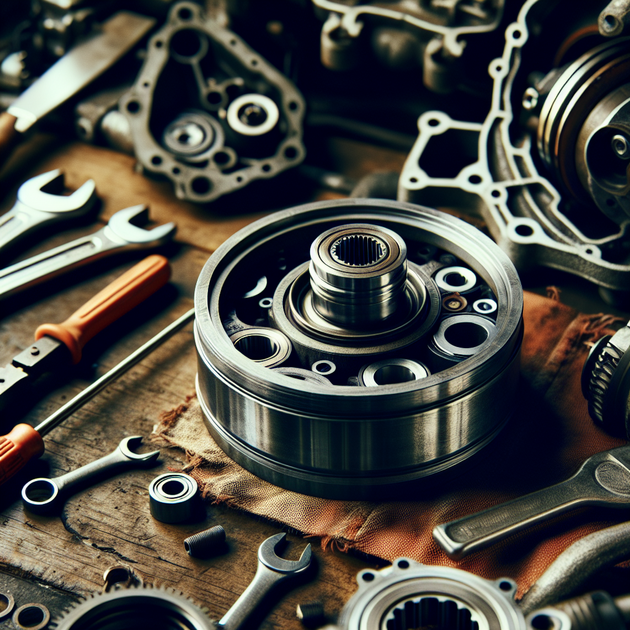Ever felt that sinking feeling after hearing a loud “crack” when you’re just trying to get one stubborn bolt loose? If you’ve just broken the harmonic balancer on your Honda Civic EG3 with the D13B2 engine, you’re probably wondering—can you still use it, or is it destined for the trash?
Let’s break down what the harmonic balancer does, why it’s so important, and what your options are if you’ve accidentally snapped it.
What Is a Harmonic Balancer and Why Does It Matter?
The harmonic balancer, sometimes called a crankshaft pulley, is a crucial part of your engine. Its main job is to reduce vibration from the engine’s crankshaft. Without it, those vibrations could eventually damage your engine’s internal parts, leading to expensive repairs down the line.
On your 1992 Honda Civic EG3 (with the D13B2 engine), the harmonic balancer is bolted directly to the crankshaft. It’s not just a chunk of metal—it’s carefully engineered with a rubber layer that absorbs and dampens vibration. If that rubber gets damaged or the balancer cracks, your engine loses vital protection.
For more details about how harmonic balancers work, check out this helpful overview from Engine Builder Magazine.
What Happens If the Harmonic Balancer Breaks?
A broken harmonic balancer isn’t something you can ignore. Here’s why:
- Unbalanced Engine: Without a functioning balancer, the crankshaft is exposed to higher levels of vibration.
- Possible Engine Damage: Over time, these vibrations can cause serious harm to bearings, the timing belt, and even the crankshaft itself.
- Accessory Problems: The balancer often drives components like the alternator, power steering, and air conditioning. If it’s broken, you risk losing those features too.
If the outer ring or the rubber damper is cracked, split, or separated, it’s generally unsafe to reuse. Even if only a piece of the lip breaks off, it might throw everything out of balance.
Can You Still Use a Broken Harmonic Balancer?
Here’s the tough love: if you’ve cracked or broken your harmonic balancer while unbolting it, it’s almost always time to replace it. The risk just isn’t worth it.
Why? Once the balancer is compromised, it can’t do its job properly. Even a small crack can lead to serious engine issues. It’s like running a marathon with a sprained ankle—it might work for a while, but you’re risking much bigger problems.
If you’re on a budget, you might be tempted to put it back together and “send it.” But when it comes to engine health, this isn’t the place to cut corners. Replacement harmonic balancers aren’t as expensive as you might think, and they’re much cheaper than a new engine.
For sourcing a replacement, sites like RockAuto or your local auto parts store will have options for your Honda Civic EG3.
How to Replace a Harmonic Balancer on a Honda Civic
Replacing the balancer on your Civic EG3 isn’t the most fun job, but it’s definitely doable with some patience and the right tools. Here are some general steps:
- Remove the drive belts attached to the balancer/pulley
- Unbolt and remove the broken harmonic balancer
- Clean the crankshaft snout and keyway to remove any debris
- Install the new harmonic balancer, lining up the keyway
- Torque the bolt to manufacturer specs (this is crucial for safety and longevity)
- Reinstall drive belts and double-check alignment
If you want to see a step-by-step walkthrough, this guide from Family Handyman covers the basics, though your Civic’s specifics may vary.
A Real-World Story
A friend once tried to “make do” with a cracked harmonic balancer on his old Accord, thinking it’d last until payday. A week later, his car developed a harsh vibration and a nasty squeal—turns out the pulley slipped, throwing his timing off and leaving him stranded. After replacing the balancer, everything ran smooth again. Moral of the story: when in doubt, swap it out!
Should You Toss the Broken Harmonic Balancer?
Short answer: yes, if it’s cracked, split, or separated, it’s time for the trash. There’s always a chance you could get away with using it for a few miles, but the risk to your engine (and your wallet) just isn’t worth it.
If you’re unsure, take the broken part to a trusted mechanic or parts shop for a second opinion. But in most cases, replacing the harmonic balancer is the safest move.
Still have questions about your specific model or what parts to buy? Drop them below or check out community forums for more advice from fellow Civic owners.
What’s the most stubborn bolt you’ve ever faced—and how did you finally get it loose?

Leave a Reply